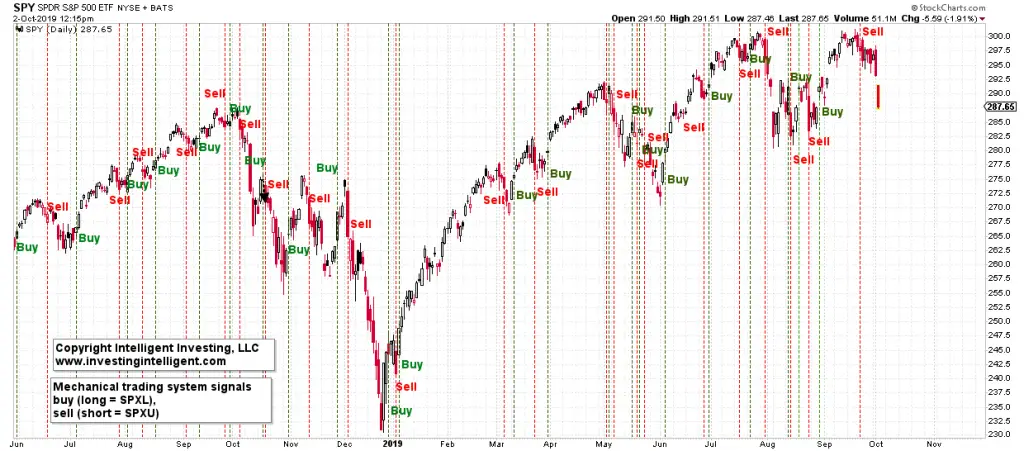This is a Guest Post by Arnout ter Schure on Twitter @intell_invest.
Using my mechanical system’s results to test the “is trading the close or open more profitable?” thesis.
SPX Trading System Signals
Some say one should only trade the close because the overnight Futures markets carry most of the stock market’s gains, see here. Others may say one should not trade the open (see here), while the first 15 minutes can create the best opportunities see here. So, which is it?!
Which is true and the best? To be 100% objective; the open is as valid as the close. The markets open for a reason: to trade. In addition, what is the open? The moment the bell rings, or 10 minutes later, or 30 minutes later? So, let’s put it to the test.
Here I use my short-term mechanical trading system, featured on my Private Twitter Trading Feed and Stocktwits.com, which is a trend following and price based trading system. This system example started trading June 1, 2018 and tracks the S&P 500 (SPX) and provides buy/sell/hold signals at the close of each trading day. The chart below shows all its signals since inception using the daily SPY chart. Signals are executed the next trading day at the open. Not at the close. But, in this study I will compare the “trade the open” results with if the system would trade the close instead.

The trading vehicles used are the 3x ETFs SPXL and 3x inverse ETFs SPXU. The former is entered when the SPX is starting to trend up according to my systems’ parameters (long), and in this study is exited when the SPX is starting to trend down according to the system. Then SPXU is entered (short) till the system signals to reverse the trade. Ad infinity. In reality, positions are also partially exited when markets are getting overbought or oversold, but that feature is not included here.
So, let’s get straight to it. At the bottom of this article is a link to the short-term systems’ trading results which has now been active for 16 months with 44 trades (less than three per month!). Plenty of data. The left three (ABC) columns shows all the “trade the open” results (actual), while the right (EFG) columns show the “trade the close” (hypothetical) results. Note the entire portfolio is always allocated to each new trade for the compounding effect. An extra trick. Here a $100,000 starting portfolio is used for ease of computing, but it can also be $50K, $10K etc. The results in percent gains & losses remain of course the same and are summarized in the tables on the right.
As you can see, since June 1, 2018 using the close to determine the trade at the open resulted in a net gain of 55% by October 2, 2019; while using and trading the close resulted in a net gain of 11%. That’s almost a factor of 5 difference. With so much actual trading data at hand and such a big difference it is clear trading the close only vs trading the open only is not advantageous. At least not with my system. Using the close to determine the trade for the next day is clearly the best strategy.
Now if we compare my short-term system’s performance to passive buy-n-hold (buy the SPY on June 1, 2018 and still holding it), you can see it beats that type of passive investing almost 1 to 10. Of course, here 3x ETFs are traded, while the SPY is a 1x ETF so if we correct for that and would have only traded SPY/SH, the difference is still 1 to 3. Clearly active trading based on the closing price beats passive buy-n-hold (in this case almost three times), and beats trading the close.
Thus, having a system in place that a) follows the price trend be it up or down, b) switches between going “long” and “short” when markets are trending up or down; respectively, and c) most importantly uses the close to determine which of the two trends it is and then trades the open the next day, is one of the better and easy to apply ways to go about in trading the markets. With on average less than three trades per month and over 55% gains by October 2, 2019 it is hard to argue against it.
Link to file: https://drive.google.com/file/d/1Ho3ytjVNLHkvcWS8-lMQzc0U_eWhitjm/view?usp=sharing
Trade safe!
Arnout Ter Schure PhD
Founder and President Intelligent Investing, LLC
Vice President NorthPost Partners, LP
